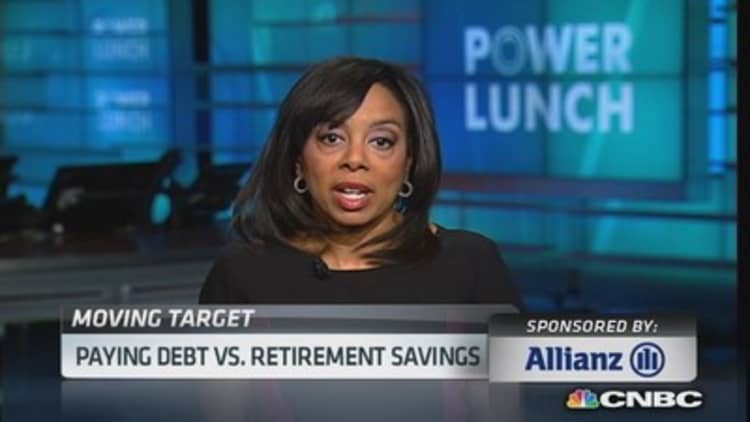
American workers stash over $300 billion a year into 401(k) accounts and other employer-sponsored retirement plans, if you include employers' matching contributions. This may sound like a lot of money, but it still may not be enough for many Americans to be able to retire.
Many workers say they would like to put more money into their 401(k) plans but simply don't have enough left after paying everyday expenses to do it.
That's the new reality. Most Americans with 401(k) and other defined contribution plans are accumulating debt faster than they're saving for retirement, according to a new report from the financial services website HelloWallet.
The amount that retirement plan participants spent to pay down debts has risen nearly 70 percent in the last 20 years, the study found. Many workers say they are unable to contribute as much as they would like to their 401(k) plan because they have more expenses and less income than they had in the past.
(Read more: Over 50? Ask your financial advisor this)
The problem is most pronounced for those closest to retirement. Half of retirement plan savers 50 to 65 are accruing debt faster than they're building up their savings, according to the HelloWallet study. They're spending an average of 22 percent of their income paying down debt.
"It's remarkable," says HelloWallet CEO Matt Fellowes. "You'd expect most people at that point to be deleveraging: paying off their mortgage, paying back their student loans or have already paid off their student loans, and not having difficulty paying off credit card debt. But in fact those are the households that are most likely to be building up debt faster than retirement savings."
The result is that these older workers have only about two years of retirement income saved. Yet Americans are living longer and will typically need about 17 years worth of retirement income after age 65.
(Read more: For 401(k)s, staying the course pays off in crises)
So what are some debt-busting strategies to ensure you can retire and won't outlive your money?
Increase retirement savings contributions
Increasing your retirement plan contributions is certainly an important step in building assets. Putting an additional 1 percent of pay into your 401(k) or employer-sponsored retirement account every year can make a big difference. At least contribute enough to receive the employer's matching contribution. You can put up to $17,500 in a 401(k), 403(b) and most 457 plans this year, and an additional $5,500 if you're 50 or older.
Stash the maximum amount into your IRA, too—up to $5,500 in 2013 or $6,500 for those 50 and over. If you reach the contribution limits on these accounts and are still behind in your savings, financial advisors suggest putting money in taxable accounts earmarked for retirement as well.
Determine your net worth
Even if you're maxing out your retirement plan contributions, it may not be enough. Advisors say it's crucial to pay attention to other side of the ledger.
"Take a look not only at your savings rate for retirement but at your net worth statement, your balance sheet," says Sheryl Garrett, a certified financial planner in Eureka Springs, Ark., and a member of the CNBC Digital Financial Advisor Council.
(Read more: Protect your retirement from rising interest rates)
An important question to always ask: "How much do you owe versus how much you own?" Make sure the answer is always heading you in the right direction, says Garrett, founder of Garrett Planning Network, a national network of over 300 of hourly based, fee-only financial planners.
Make a budget and stick to it
Fellowes says about 85 percent of Americans don't adhere to a regular budget. Free online tools at Mint.com, BudgetTracker.com and Budgetpulse.com can help you, so you can start paring debt. But you don't necessarily need financial services software or mobile apps to manage your money.
"It can be as simple as pencil to paper," Garrett said. "The main thing is to focus on making contributions [to savings] as well as how much money is going out."
Reduce expenses to manage cash flow
Finally, as you focus on managing your cash flow, consider taxes, savings, rent and mortgage, and other committed expenses, including debt obligations. And take a hard look at your lifestyle, Garrett said. You may need to reduce many expenses now to ultimately reach your retirement goal.





